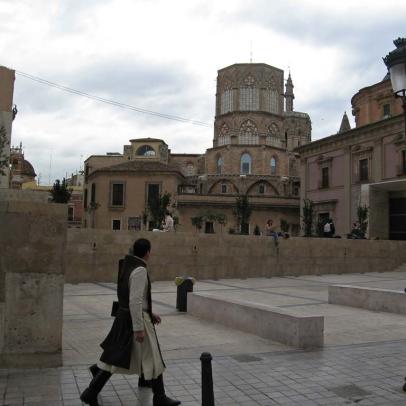The Archeological Centre of La Almoina is one of the most outstanding archeological sites along The Way of El Cid. It is worth the visit! This is a covered archeological site, whose samples show, on site, interesting archeological remains of the Roman, Visigoth and Arab city. The site contains also a large number of pieces (ceramic, coins, household tools, etc.) found in the area, which can be traced back to those periods.
The fact that this archeological site is situated in the middle of the old city centre allows visitors to go down the thermal springs and the forum of the Roman civitas, whose regular plan is still visible. As a matter of fact, the form of the town is imparted by two main streets: the cardo and the decumanus. In the southern part, there is a Visigoth area, displaying a baptistery, an apse built in honour of San Vicente and several monumental tombs.
The eastern part of the site marks the location of the Islamic fortress. The remaining parts of the fortress include a waterwheel, a patio with a reservoir and some parts of a fortification. The total surface area of the fortress, which was very large, reached the site that is now home to the Almudín and other places in the surrounding area.
L'Almoina has been chosen as a key place in Valencia because of the high value of this monument and of the remains that have been found in the fortress area. From a literary perspective, Valencia is in El Cantar de Mío Cid the dreamt city. According to the poem, El Cid conquered the city after a long siege.
The King of Seville was intent upon retaking the city from El Cid, but he was defeated in a pitched battle held in the orchards of Valencia. El Cid reconciled then with King Alfonso VI. Following El Cid’s victory, his wife and daughters travelled to Valencia, where El Cid met them in front of the city’s main gate. He displayed his skill in arms to his wife and daughters with great pomp, bringing them to the citadel, to the very highest place: the fortress tower, from where they gazed about them (the orchards).
Some time later, the chief of the Almoravids, Yussuf, gathered a huge army of 50,000 men to take control of Valencia. Yet, he was defeated. After this victory, the wedding of El Cid’s daughters and the Infantes de Carrión was celebrated in Carrión.
Two years later the King Búcar attempted to retake Valencia with a very powerful army (made of 50,000 men according to the poem). Búcar was defeated. El Cid killed him and gained possession of the famous sword Tizona, worth more than 1,000 marks of gold.
This is a sign that his honour was avenged. El Cid became thus lord of Valencia, after which he died. The poem ends with his peaceful death in Valencia.
Historical records indicate that Valencia was conquered by the Almoravids within four years of El Cid’s death. The building of la Almoina, whose name refers to the place where the poor and needy are given support, was constructed after the conquest of Valencia by Jaime I in the 13th century.
Visits. Admission tickets. For further information please contact "Centro Arqueológico".
Rev. PAB 26.12.18


